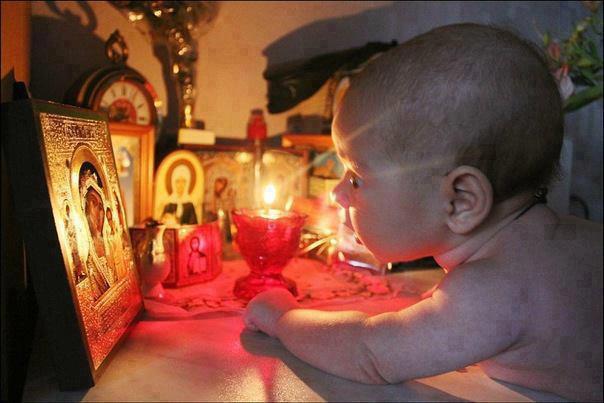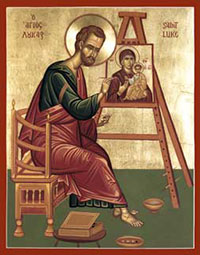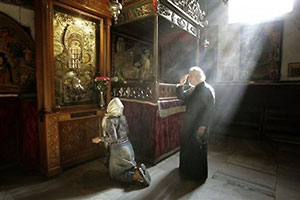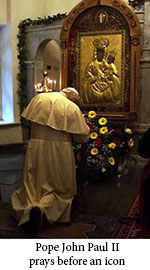
Since Saint Luke the Evangelist painted the first icons of the Blessed Virgin, iconography has been the traditional art form of Christians throughout the world, and an integral part of Christian worship and mystical life.
Referred to in the Christian East as "windows into heaven," they have inspired and uplifted millions of the faithful, and have at times been the instruments for demonstrating God's miraculous intercession in the life of mankind.
Who was the first iconographer?
 Church tradition teaches that Saint Luke painted the holy image of the Virgin Mary, a face which he himself had seen. He brought his first icons to the Mother of God herself, who approved them and proclaimed: "May the grace of Him Who was born of me, through me, be imparted to these icons." There are at least five highly-venerated icons of the Virgin painted by Saint Luke which are still venerated today. He is also known to have painted icons of Saints Peter and Paul. The beginnings of iconography can also be found in the catacomb paintings of the second and third centuries.
Church tradition teaches that Saint Luke painted the holy image of the Virgin Mary, a face which he himself had seen. He brought his first icons to the Mother of God herself, who approved them and proclaimed: "May the grace of Him Who was born of me, through me, be imparted to these icons." There are at least five highly-venerated icons of the Virgin painted by Saint Luke which are still venerated today. He is also known to have painted icons of Saints Peter and Paul. The beginnings of iconography can also be found in the catacomb paintings of the second and third centuries.
What is an icon?
Icon is the Greek word for "image" (eikon). But what we now identify as an icon goes far beyond this simple definition. The elements of this art form were most clearly defined and established under the early Byzantine Empire. The archetypal portraits of Christ, the Holy Virgin and the Saints, and the Gospel scenes painted during this formative time established the classic tradition that endures to our own time.
What is the purpose of an icon?
To begin with, the icon reminds, inspires and educates. For centuries Christians looked to the icons that filled their homes and churches for heavenly help and inspiration, and to keep the memory of their holy helpers ever at hand. And as Saint Basil the Great wrote, "With a soundless voice the icons teach those who behold them." And also: "What the Book of the Gospels explains by means of words, the iconographer shows by means of his works."
But even more…
 Although the Christian East and the Christian West share a tradition of veneration for sacred images, the East has gone a step further than the West. Beyond holy remembrance, beyond a focal point for prayer, the East sees an icon as a special "incarnation" of God's grace in the world, through which heavenly realities can touch us and be experienced. Not that the icon is an idol to be worshipped in and of itself, but that in response to the aspiring hearts of the faithful it becomes "alive" and we can experience the presence of the Savior, the Holy Virgin, or the saint depicted. As Saint John Damascene wrote in In Defense of Icons, "The icons of the saints are filled with the Holy Spirit."
Although the Christian East and the Christian West share a tradition of veneration for sacred images, the East has gone a step further than the West. Beyond holy remembrance, beyond a focal point for prayer, the East sees an icon as a special "incarnation" of God's grace in the world, through which heavenly realities can touch us and be experienced. Not that the icon is an idol to be worshipped in and of itself, but that in response to the aspiring hearts of the faithful it becomes "alive" and we can experience the presence of the Savior, the Holy Virgin, or the saint depicted. As Saint John Damascene wrote in In Defense of Icons, "The icons of the saints are filled with the Holy Spirit."
The history of miraculous icons shows this is not mere metaphor. The sacred history of the East is filled with accounts of icons that appeared miraculous, that bleed when cut by iconoclasts, that wept healing myrrh oil, and more. Such icons still exist today.
What makes a religious painting "an icon"?
The elements of iconographic style usually include:
- Standardization. Upon seeing an icon we can immediately recognize that this is Christ, this is Saint Paul, this is Saint Nicholas, etc. Both the forms of the Saints and the composition of the events from the Gospels are fixed and archetypal, although they will vary slightly according to the iconographer.
- Stylization. Icons are not naturalistic or "technically correct." In fact, the faces and figures of the holy ones depicted are not quite human. Renowned Greek iconographer Photios Kontoglou write: "Even if he has seen a certain saint in life, the iconographer does not paint him matieralistically or naturally, but in a spiritual manner, illumined by divine grace." Even the geometric folds of their clothes speak of a heavenly order and balance.
- Simplicity. Buildings, mountains, trees and animals are usually depicted in a very simplified, schematic way, rather than attempting to render a photographic likeness.
- Spiritually transformed time and space. To achieve this effect the iconographer may depict events that took place at different times are represented simultaneously in the composition as if they took place simultaneously, such as the classical Nativity icons that show the Virgin with the swaddled Infant, the midwives bathing the Child Jesus, the angel announcing the Savior's birth to the shepherds, and the Magi coming to adore the Messiah. The iconographer may also uses an inverted perspective in which objects in the foreground are smaller than spiritually more significant objects or persons behind them.
- "A snapshot in eternity." Even such dynamic events as the raising of Lazarus or the Crucifixion of Christ there is a balance and serenity in the composition that renders the subject beyond space and time. The iconographer's goal is to use stylization and order to reveal the timeless and heavenly nature of a moment in time-bound earthly history. "Icons raise the soul and mind to the realm of the Spirit" (Photios Kontoglou).

Iconography in the Christian West
Although many of us associate iconography with the Church of the East, it is also the original tradition of sacred art in the Western Church. Mosaics, frescoes, and paintings in Rome, Spain, and France bear witness that the Byzantine style was the artistic tradition common to both Western and Eastern Christianity up to the twelfth century.
TO LEARN MORE about the rich tradition and meaning of icons, browse the many articles in the Did You Know? section of our website, including:
..and more.